KS2 SATs 2024: Maths Papers Question Breakdown
This article was originally published on 24th May 2024. Here is the KS2 SATs 2025 analysis.
After what felt like a long week for schools, the 2024 KS2 SATs embargo has now been lifted. We can finally talk about the SATs content in detail. Here, we’ll provide an in-depth question-level analysis of this year’s papers, including content domain and year group coverage for Year 6 teachers and school leaders.
If you’re short on time, or need a summary to share with staff, don’t miss the free download: Maths SATs 2024 Question Breakdown: Staff Discussion Points
Despite COVID now a seemingly distant memory, the impact continues in schools. 2024’s Year 6 cohort missed their KS1 SATs and a considerable proportion of school time in years 2 and 3. Both are key years for building essential foundations in maths.
GET THE ANALYSIS ON PREVIOUS SATS
SATs have been running in their current incarnation for 7 years; there were no government standardised assessments in 2020 and 2021 as a result of the Covid-19 pandemic. Get all the analysis and results from previous national assessments below.
And find out which are the top 20 year 6 maths revision topics to focus on this year.
– SATs papers 2025
– SATs results 2025
– SATs papers 2024
– SATs results 2024
– SATs papers 2023
– SATs results 2023
– SATs papers 2022
– SATs results 2022
– SATs papers 2019
– SATs results 2019
– SATs papers 2018
– SATs results 2018
– SATs papers 2017
– SATs results 2017
– SATs results 2016
What to expect from this article
This article looks in-depth at a breakdown of all three maths KS2 SATs papers for 2024. As always, the greatest focus is on the two reasoning papers which give children the best opportunity to demonstrate their depth of understanding.
These papers often generate the most debate, discussion, and in some cases, controversy.
For each paper, we’ll explore:
- The difficulty and cognitive demand
- Year group coverage
- Content coverage
- Question structures
- How this year’s papers compare to previous years’ papers
We finish with tried and tested tips from our maths expert, Emma, for preparing for the maths KS2 SATs papers 2025.
Maths SATs 2024 Question Breakdown: Staff Discussion Points
Download this presentation to take you through the top 16 points from our question-level analysis of the KS2 SATs 2024 maths papers, includes example questions from the 2024 maths SATs papers. Can be used in staff meetings.
Download Free Now!Difficulty and cognitive demand of the KS2 SATs 2024 maths papers
As soon as pupils complete the SATs papers, the first question asked is “How hard were the papers this year?”
Before we look at the 2024 papers in detail, let’s look back at some of the key observations made by Third Space Learning over the previous three cycles of SATS exams.
KS2 SATS 2019 Maths Papers Question Breakdown
‘The papers all seemed to have massive ‘cliff edges’ in difficulty this year….The overall cognitive complexity of the questions was higher than in previous years….The work required for one or two marks was higher than previous years….The level of spatial awareness and processing required was also high.’
KS2 SATS 2022 Maths Papers Question Breakdown
‘Mixed response to the level of difficulty and cognitive demand.….Fair in regards to challenging those children who should be aiming for greater depth in maths…..The question images tripped up some children on at least 2 examples….The proportion of questions testing Year 6 content has reduced…..Contexts for questions seemed much more relatable…..Question setters showed an impressive ability to over-complicate.’
KS2 SATS 2023 Maths Papers Question Breakdown
‘The lowest percentage of year 6 content of all the previous 5 cycles of SATS exams (36%)…. No cliff edge and a more gradual increase in difficulty……the number of marks did not always match the amount of work required……increased content from the year 3 curriculum….The expected standard could be achieved with no year 6 maths…..Contexts for questions were again generally relatable……The level of spatial awareness required was high.’
SATS 2026: STAY UP TO DATE
Join our email list to stay up to date with the latest news and free resources for SATs 2026. As usual our expert teachers will be on hand to provide one to one tuition support, revision resources, expert paper analysis, SATs teacher survey results and the SATs results 2026.

Unlimited primary maths tutoring with Skye, the voice-based AI maths tutor.
Built on the same principles, pedagogy and curriculum as our traditional tutoring, but with more flexibility, reach and lower cost.
Join the schools already helping hundreds of primary pupils nationwide with Skye’s one to one maths tutoring.
Watch Skye in actionWhat did teachers think of the maths KS2 SATs papers 2024?
Year after year the SATs produce mixed reactions across social media. 2024 is no different.
All three papers prompted a range of reactions but it was Reasoning Paper 2 that provoked the most extreme contrast.
Reactions ranged from the paper being ‘horrific’ and ‘vile’….


To being ‘ok’ and ‘not too bad’.


Overall, the consensus on social media and in the Third Space Learning 2024 review of Maths SATS teacher survey was that Reasoning Paper 2 was more challenging than Arithmetic Paper 1. Reasoning Paper 3 caused mixed reactions.


Despite mixed reactions, the overall feeling was that the 2024 maths papers were challenging. 72% of respondents of the 2024 Third Space Learning Review of Maths SATs Teacher Survey felt the maths papers were harder than 2023 Many felt the Reasoning Paper 2 was too wordy which made it more challenging, particularly for EAL pupils.
Overall consensus of the three maths SATs papers: a return to ‘cliff edge’ questions
In previous years, we have seen a lot of discussion around a ‘cliff edge’ in the papers. A phrase that describes a sudden jump in the level of cognitive demand required to answer a question.
Traditionally, the three papers increase in difficulty, starting with easier questions and progressing to more challenging questions.
Last year this was more of a gradual increase across all three papers. This year, the papers increased in difficulty as expected. However, while there was no sudden increase or ‘cliff edge’ in Arithmetic paper 1, both Reasoning Papers 2 and Paper 3 had a clear turning point where the level of cognitive demand required stepped up suddenly and considerably.
KS2 SATs 2024: Arithmetic Paper 1
Arithmetic Paper 1 started with all four operations covered in the first four questions. All using small numbers. The first 13 questions contained only addition, subtraction, multiplication and division questions before introducing fractions questions.
As with the 2023 arithmetic paper, the first time questions increased in difficulty was around question 20 – the first 2-mark question. Here pupils had to multiply a 4-digit number by a 2-digit number.

Although this question did mark the start of increasingly complex questions, there were still some basic, straightforward questions after this one.
KS2 SATs 2024: Reasoning Paper 2
Question 17 in Reasoning Paper 2 saw an increase in difficulty, just as in 2023. While this was a gentle difficulty incline in 2023, this year was more of a cliff edge. Question 17, a 2-mark question, required pupils to complete 3 steps.
It went beyond the typical SATS-style question of finding the total and calculating change question. There was an additional challenge of using the given cost of items and change given, to calculate the missing price of one of the items.

KS2 SATs 2024: Reasoning Paper 3
This year there was an earlier increase in difficulty of Reasoning Paper 3, question 13 proved more difficult compared to question 16 last year.
Question 13 did not involve hugely complex maths but it did contain 5 calculations involving both whole numbers and decimals. This presented lots of opportunities for error.

Too few marks offered for too much work
Recent SATs cycles included questions in the maths reasoning papers that required a higher level of processing and cognitive demand than the marks awarded would suggest.
This year was a common complaint again this year.



Reasoning Paper 2 and Paper 3 had several examples of questions that required multiple steps for only 1 or 2 marks.
In paper 2, Question 17 the ‘cliff edge’ shopping question prompted a lot of discussion. This question required pupils to complete 3 steps involving both addition and subtraction calculations for only 2 marks. Comparable questions found in GCSE maths papers, students are awarded 3 marks:

Question 10 in Reasoning Paper 3 required children to measure 4 different sides of a shape with a ruler and use these readings to calculate the perimeter. It presented 5 opportunities for error to be made for only 1 mark.

Question 24 also required multiple steps for only 1 mark.

Pupils needed to multiply fractions twice and compare the size of the two fractions.
Breakdown of the year group coverage by KS2 SATs 2024 paper
Significant increase in the proportion of Year 6 content coverage
Post-Covid, the KS2 maths SATs papers decreased the percentage of questions from the Year 6 curriculum. 2022 saw a 10% decrease from 2019 and a further 1% in 2023.
Given that the post-pandemic catch is still happening, one would hope 2024 would follow suit. However, this was not the case. Across the three maths papers, 48% of the questions covered Year 6 curriculum content. This was a huge 12% increase from 2023 and the most Year 6 curriculum content included in SATs since 2017.
Looking at the Year 5 and 6 curriculum coverage combined, the percentage of UKS2 content is broadly similar to 2023, accounting for 67% of the papers. Content from Years 3 and 4 was also similar to previous years.


Arithmetic Paper 1
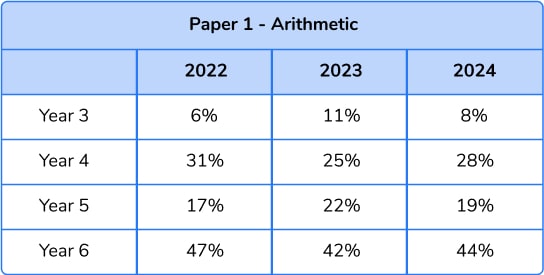
There was not a huge variation in the year group content coverage to previous years for Arithmetic Paper 1. Year 6 arithmetic coverage increased slightly from 42% in 2023 to 44%. However, this was not as high as 2022.
Looking to develop pupil maths fluency beyond SATs? Try Third Space Learning’s most popular daily arithmetic resource, Fluent in Five.
This daily scheme helps to build arithmetic skills through regular daily practice. Download the first six weeks of Fluent in Five for free.
Reasoning Paper 2

Following Reasoning Paper 2, many took to social media to share their frustration with an overarching consensus that the paper was challenging. Some commented that it reduced their pupils to tears. Reflecting on the year group coverage in paper 2, these reactions are unsurprising. 48% of the content in Reasoning Paper 2 came from the Year 6 curriculum – this has doubled since 2023.
In addition to a large increase in Year 6 content, there was a big decrease in Year 5 content with 26% fewer marks coming from the Year 5 curriculum for 2024. Like the Year 6 content, the Year 3 curriculum content doubled from the previous two SATs cycles.
Reasoning Paper 3

Reasoning Paper 3 also saw an increase in the percentage of Year 6 content assessed. With a 12% increase from 2023, at a huge 54% over half of Reasoning Paper 3 was Year 6 curriculum content.
Questions arose last year whether the fall in Year 6 content was a response to the impact of the COVID-19 pandemic. If it was, it would appear that there are no more allowances for the impact of COVID-19 on today’s school pupils and any learning loss.
Provide pupils with ongoing reasoning practice to ensure they are equipped to start Year 7 with strong mathematical knowledge.
Download the first six weeks of Rapid Reasoning for free to see you through the rest of the summer term.
Could children reach the expected level without exposure to any year 6 content?

Although the 2024 scaled scores are not yet released, it appears more difficult to reach the expected standard without any exposure to the Year 6 curriculum than it has for the past two SATS cycles.
Content coverage is reverting to pre-pandemic standards, with 52% of content coverage from the Year 3 to 5 curriculum (compared to 64% in 2023 and 63% in 2022). All schools and pupils can do now is wait to see the impact the increased percentage in Year 6 content has on the percentage marks required to reach the expected level.
Breakdown of the KS2 SATs 2024 paper by content domain
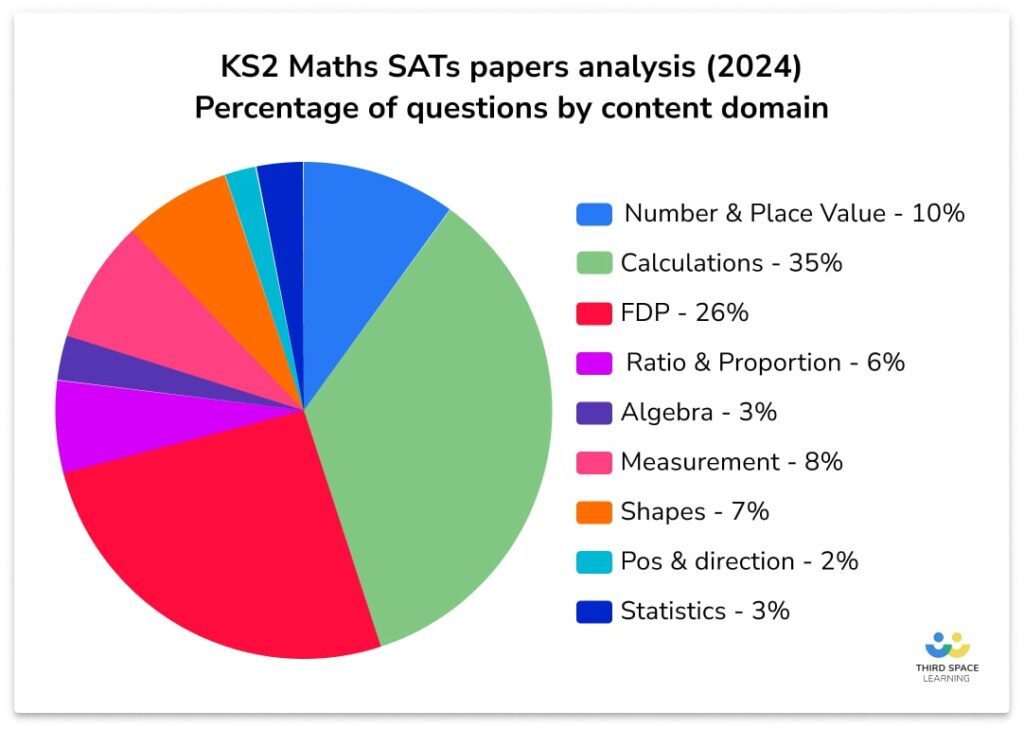

Overall, the content coverage across the three papers is broadly similar to previous years. Again, the largest percentage of questions in 2024 fall under the calculation content domain at 35%, an increase of 3% from 2023. Fractions, decimals and percentages follow at 26%.
Across the three papers, these two content domains combined account for 61% of the marks and continue to require the most focus and attention when preparing pupils for SATs. Include number and place value in this figure and 71% of questions cover these three content domains alone.
Breakdown of arithmetic

Potential for high marks from only a few question types
Over the past three years, there has been little variation in the breakdown of the arithmetic paper when looking at the content domain. When looking in detail at the questions in the 2024 paper, it is clear pupils can score high marks only covering a few key topics:
- Calculation continues to account for the highest percentage of marks at 60%
- 32.5% of the marks are awarded to fractions, decimals and percentages questions year
- 92.5% of questions covered calculation or fractions
- The first 13 questions were simple calculation questions
- 5 of the first 15 questions required only short division
- 60% of the paper involved the four operations, both whole numbers and decimals
- 65% of the order of operations questions were in the 60% of four operations questions
- 18% of questions used the four operations with fractions
Question structures for the 2024 Arithmetic Paper 1
Answer followed by the question
Yet again, the arithmetic paper included many questions with the answer box positioned at the start of the question. Although they weren’t as prevalent as they were in the 2023 paper, there were enough to warrant exposure to this question-type in advance.

Repetition of question type increasing in difficulty
As with the arithmetic paper every year, there are certain question types repeated with increasing difficulty.
The ability to complete multiplication and division calculations was essential for pupils to score highly on the arithmetic paper.

Breakdown of reasoning

Distribution of marks across both reasoning papers is similar year-on-year. Here are a few notable observations:
- Calculation continues to account for the highest percentage of questions in the two reasoning papers, closely followed by fractions and decimals.
- Fractions is the only domain with a gradual increase over the past six SATs cycles, starting at 14% in 2017 and increasing to 19% in 2024
Question structures for the 2024 Reasoning Paper 2 and Paper 3
Question context is more relatable than in previous years
Over the years, there have been many strange SATs questions using contexts children cannot relate to or contextualise.
In the past two SATs cycles, there’s been a shift away from this to more relatable questions for 10 and 11-year-olds.
For example:
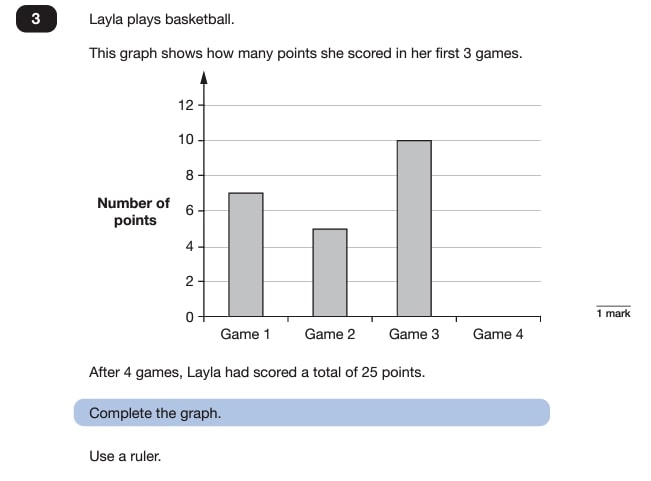

However, it would seem that the SATs writers chose not to include any contex to question 14 on paper 3.

The annual SATs favourite of ‘How much change?’ appeared in paper 3. A modified version also appeared in paper 2.

Although not all questions were entirely relatable. In question 18 on paper 3, Layla saved for a camera from the 1990s. While cameras from the 90’s seem to be making a return, this is not an item all 10 and 11-year-olds born in 2013 and 2014 would recognise. An unnecessary distraction from maths.
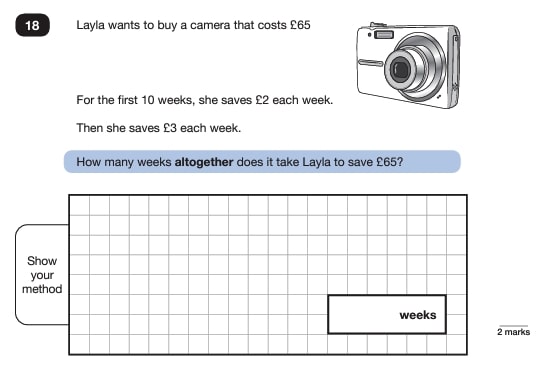
Images were not always helpful
Accompanying questions with images can be helpful, but they can also mislead pupils and cause confusion. Images were a common complaint in our 2024 teacher review survey.
At first glance of question 22 on paper 3, the image was an instantly recognisable ratio question using black and white beads. However, this was not accurate, instead, the question required algebra, not ratio. Introducing an algebra question with a familiar ratio image was not helpful.
Children need to be aware that the images in SATs questions won’t always help and they should read each question carefully to decide what method or calculation is required.

Representing abstract word problems pictorially
While some images were not helpful, some questions did not provide images at all. Children need to be able to draw pictorial images to help solve several of the more abstract questions used this year.
Towards the end of KS2, using images is frequently forgotten. Pictorial images are often associated with younger children or those who struggle with maths.
Question 27 on paper 2 evidenced why teachers should encourage all children to use pictorial representations where appropriate.
Despite being a mathematically straightforward question, the wording of this question was unnecessarily confusing. Pupils simply needed to use a pictorial representation to work out the solution.

To answer this, children just needed to draw two bar models, to represent the two jars. Like the jars, the second bar model is half the size of the first with the smaller bar model split in half and the larger one split into quarters.
With a simple bar model, it is clear that 25% of jar A is the same as 50% of jar B

Drawing an image would also have been helpful for question 14 on paper 2. Another abstract question where a simple bar model would help pupils work out how many children were in the class.


A rise in missing number calculations for all four operations
Missing number calculations are used more frequently in reasoning papers. Last year there was a long multiplication missing number calculation. This year included subtraction, multiplication and division missing number calculations.
Children need to be secure in the four operations with missing numbers. Across both reasoning papers, a total of 5 marks were allocated to this type of question.

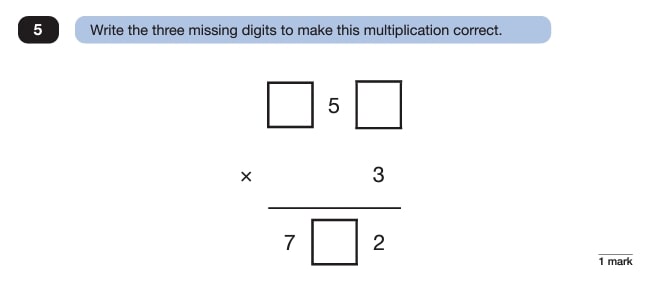

Understanding key mathematical vocabulary
SATs prove that children need a solid understanding of mathematical vocabulary. Last year, pupils needed to know the terminology for circles. This year, they needed to know the mathematical terminology for a range of topics including:
- Prime numbers
- Square numbers
- Cube numbers
- Common multiples
- Common factors
- Parallel and perpendicular lines


Unusual terminology
In addition to having a secure understanding of mathematical vocabulary, pupils also needed to know some more obscure terms. Using the phrase ‘angle measurer’ instead of ‘protractor’ on question 10 in paper 3 confused some children.

It also seems odd to use the word ‘least’ when it makes more sense to use ‘lowest’ or ‘smallest’.

Children need to know that SATs paper language may not be as they are used to but not to let the use of words they are not familiar with throw them off.
Reduced focus on spatial awareness and increased focus on mathematical equipment
In recent years, many questions required spatial awareness. However, this year there was only one basic symmetry question.
This year, the papers required children to demonstrate their competence with mathematical equipment, specifically rulers and protractors. Three questions asked pupils to use a ruler, including the perimeter question mentioned above, and one requiring a protractor.

Repeated question types
One question generally repeated every year is ‘What number did x think of?’ In these questions, children need to work backwards or use algebra to work out the number.
Children must have exposure to this type of question to ensure they know how to tackle it when it comes up.

Reasoning Paper 2
Don’t assume concepts won’t be covered
While some concepts appear less frequently than others, it should never be assumed that concepts won’t appear altogether.
Some children were caught off-guard when asked to give the long division remainder as a fraction.

Others were stuck on algebra questions. Two questions required pupils to use algebra, the bead question mentioned previously, and a missing numbers question in paper 2.

If a concept is in the National Curriculum, there is a chance it could appear in the SATs papers, even if it hasn’t been seen before.
Reasoning Paper 3
3 mark question
A 3-mark question is guaranteed every year and it usually appears at the same point – towards the end of paper 3.
As seen previously, the 3-mark question this year did not increase in complexity or cognitive demand. But, the number of steps needed to complete the question increased.
Mathematically, the 3-mark question was relatively straightforward – a multiplication calculation, followed by subtraction, then division.
If children are prepared and practice multi-step questions by breaking them down into individual steps, they are relatively easy marks.

What content was missing?
The content for each question is detailed on page 4 of the mark scheme. According to the listed domains, the following areas were missing from the 2024 KS2 maths SATs papers:
- Counting up and down in fractions
- Rounding decimals
- Scale factors
- Enumerate possibilities of combinations of two variables
- Measuring and comparing lengths, masses, volumes/ capacities
- Telling the time on an analogue clock
- Calculating the volume of cubes and cuboids
- 3-D shape nets
- Identifying parts of a circle
- Converting between fractions, decimals and percentages
Tips to prepare for the 2025 maths SATs paper
SATs may have only just finished for another year, but insights to help teachers get ahead for next year are always helpful.
While thinking about SATs 2025 is likely the last thing you want to do right now, save these ideas to come back to later.
- Ensure children have a strong grasp of the four operations, both whole numbers and decimals
- Build confidence using the four operations with fractions
- Include missing number calculation questions for all four operations in practice
- Encourage children to draw visual images for any abstract questions, such as fraction or percentage questions
- Regularly use mathematical equipment such as rulers, protractors and mirrors to build confidence
- Focus on a wide range of mathematical vocabulary
- Break down longer questions into smaller steps, particularly 3-step problems like children will encounter in the 3-mark question
- If it is in the National Curriculum, it could appear in the SATs, ensure it is taught in class
KS2 SATs 2024 papers are done and dusted: what now?
With an intense 8 month build-up to KS2 maths SATs and almost two months remaining until schools break up for summer, it’s tempting to ease the pace.
However, maths learning needs to continue. Some curriculum topics may have been skimmed over to cover the main topics in time for SATs, or there may be concepts the children haven’t fully grasped but will need in Year 7.
Once the results come back, in July, Maths Leads must have the chance to analyse the papers and fully understand their cohort’s performance in each content domain. This analysis is a prime opportunity to identify the school’s strengths and highlight areas that may require more focus next year.
The main task for Year 6 teachers now, alongside end-of-year activities like plays, assemblies, and residentials, is to ensure the children are as prepared as possible for the transition to Year 7.
But most importantly, don’t forget to celebrate all your and your pupils’ hard work!
How did Third Space Learning work out the year group and content domain coverage percentages?
Where two or more references are given, we have taken the primary reference as the reference that informs the data. For example, for question 24 on Reasoning Paper 2, the given references are 5F10/4F8/4C2. We have used the primary reference for this question of 5F10, therefore classifying the question as a Year 5 fractions question.
When converting to percentages, these figures have been rounded down. In such form, these are just shy of 100%.
DO YOU HAVE STUDENTS WHO NEED MORE SUPPORT IN MATHS?
Skye – our AI maths tutor built by teachers – gives students personalised one-to-one lessons that address learning gaps and build confidence.
Since 2013 we’ve taught over 2 million hours of maths lessons to more than 170,000 students to help them become fluent, able mathematicians.
Explore our AI maths tutoring or find out about year 6 SATs for your school.







